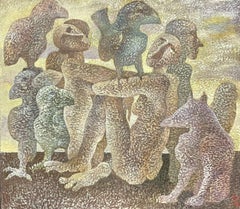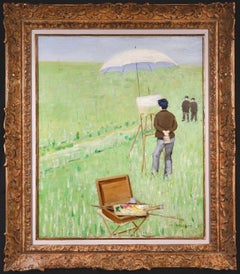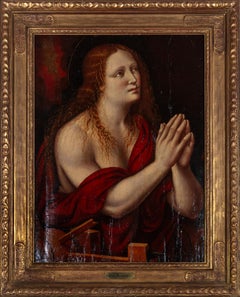Russian School Art
to
2
1
1
1
1
1
Russian Icon 16th century The Battle of the Novogorodians with the Suzdalians
By Russian School
Located in London, GB
The Battle of the Novogorodians with the Suzdalians
16th century
Size 50.5 x 47.5 x 3 cm.
The icon is located in the Russian Federation.
There is an expert opinion from leading R...
Category
16th Century Old Masters Russian School Art
Materials
Wood, Egg Tempera, Wood Panel
Tranquil Venetian Canal Backwater by Russian Impressionist artist, signed
By Russian School
Located in Cirencester, Gloucestershire
Venice
Russian School, indistinctly signed front and back
oil painting on canvas, unframed
canvas: 24 x 20 inches
provenance: private collection, UK
condition: very good and sound co...
Category
Late 20th Century Impressionist Russian School Art
Materials
Oil, Canvas
HUGE RUSSIAN SURREALIST ABSTRACT FIGURATIVE OIL PAINTING - SIGNED & DATED 2001
By Russian School
Located in Cirencester, Gloucestershire
Artist/ School: Russian School, indistinctly signed verso and dated 2001.
Title: Surrealist figurative group
Medium: oil painting on canvas signed
S...
Category
21st Century and Contemporary Russian School Art
Materials
Canvas, Oil
Related Items
Painting en plein air - Impressionist Figure in Landscape Oil by Charles Angrand
By Charles Angrand
Located in Marlow, Buckinghamshire
Signed and dated oil on canvas by French impressionist painter Charles Theophile Angrand. This wonderful and good-sized piece depicts an artist painting "en plain air" in a beautiful...
Category
1880s Impressionist Russian School Art
Materials
Canvas, Oil
"Caterina d'Alexandria (Saint Catherine of Alexandria)" classical religious
By (After) Giampietrino
Located in Milwaukee, WI
"Caterina d'Alexandria (Saint Catherine of Alexandria)" is an original oil painting on wood panel, likely painted by Italian artist Giampietrino (Giovanni Pietro Rizzoli). The painti...
Category
19th Century Old Masters Russian School Art
Materials
Oil, Wood Panel
Large Japanese Wood Board Ema Namban Depicting a Portuguese Ship Edo period
Located in Stockholm, SE
An Ema is a votive plaque people hang in a "dedication area", at a Shinto shrine, with their wish to the gods. Wishes usually would revolve around health, love, career, prosperity, a...
Category
Mid-19th Century Realist Russian School Art
Materials
Wood, Tempera, Egg Tempera, Wood Panel
Italian Landscape With Figures at a Waterfall by a Follower of Jan van Huysum
By Jan Van Huysum
Located in Stockholm, SE
There are so many details to fall in love with in this 18th-century painting depicting an Italianate landscape, for example, the delicately painted figures having a conversation and ...
Category
Early 18th Century Old Masters Russian School Art
Materials
Wood Panel, Oil
Free Shipping
H 9.65 in W 13.98 in
Old Woman and Boy with Candles, Oil on Panel, 1800s
Located in Stockholm, SE
In this painting titled "Old Woman and Boy with Candles" an intriguing scene unfolds before our eyes. An older woman gazes ahead, her eyes shielded from the flickering candlelight, w...
Category
19th Century Old Masters Russian School Art
Materials
Oil, Wood Panel
The Resurrection of Christ
Located in New York, NY
Provenance:
with “Mr. Scheer,” Vienna, by July 1918; where acquired by:
Jindřich Waldes, Prague, 1918–1941; thence by descent to:
Private Collection, New York
Literature:
Rudolf Kuchynka, “České obrazy tabulové ve Waldesově obrazárně,” Památky archeologické, vol. 31 (1919), pp. 62-64, fig. 5.
Jaroslav Pešina, “K datování deskových obrazů ve Waldesově obrazárně,” Ročenka Kruhu pro Pěstování Dějin Umění: za rok (1934), pp. 131-137.
Jaroslav Pešina, Pozdně gotické deskové malířství v Čechách, Prague, 1940, pp. 150-151, 220.
Patrik Šimon, Jindřich Waldes: sběratel umění, Prague, 2001, pp. 166, 168, footnote 190.
Ivo Hlobil, “Tři gotické obrazy ze sbírky Jindřicha Waldese,” Umění, vol. 52, no. 4 (2004), p. 369.
Executed sometime in the 1380s or 1390s by a close associate of the Master of the
Třeboň Altarpiece, this impressive panel is a rare work created at the royal court in Prague and a significant re-discovery for the corpus of early Bohemian painting. It has emerged from an American collection, descendants of the celebrated Czech industrialist and collector Jindřich Waldes, who died in Havana fleeing Nazi-occupied Europe.
The distinctive visual tradition of the Bohemian school first began to take shape in the middle of the fourteenth century after Charles IV—King of Bohemia and later Holy Roman Emperor—established Prague as a major artistic center. The influx of foreign artists and the importation of significant works of art from across Europe had a profound influence on the development of a local pictorial style. Early Italian paintings, especially those by Sienese painters and Tommaso da Modena (who worked at Charles IV’s court), had a considerable impact on the first generation of Bohemian painters. Although this influence is still felt in the brilliant gold ground and the delicate tooling of the present work, the author of this painting appears to be responding more to the paintings of his predecessors in Prague than to foreign influences.
This Resurrection of Christ employs a compositional format that was popular throughout the late medieval period but was particularly pervasive in Bohemian painting. Christ is shown sitting atop a pink marble sarcophagus, stepping down onto the ground with one bare foot. He blesses the viewer with his right hand, while in his left he holds a triumphal cross with a fluttering banner, symbolizing his victory over death. Several Roman soldiers doze at the base of the tomb, except for one grotesque figure, who, beginning to wake, shields his eyes from the light and looks on with a face of bewilderment as Christ emerges from his tomb. Christ is wrapped in a striking red robe with a blue interior lining, the colors of which vary subtly in the changing light. He stands out prominently against the gold backdrop, which is interrupted only by the abstractly rendered landscape and trees on either side of him.
The soldiers’ armor is rendered in exacting detail, the cool gray of the metal contrasting with the earth tones of the outer garments. The sleeping soldier set within a jumble of armor with neither face nor hands exposed, is covered with what appears to be a shield emblazoned with two flies on a white field, somewhat resembling a cartouche (Fig. 1). This may be a heraldic device of the altarpiece’s patron or it may signify evil, referencing either the Roman soldiers or death, over both of which Christ triumphs.
This painting formed part of the collection assembled by the Czech industrialist and founder of the Waldes Koh-i-noor Company, Jindřich Waldes, in the early twentieth century. As a collector he is best remembered for establishing the Waldes Museum in Prague to house his collection of buttons (totaling nearly 70,000 items), as well as for being the primary patron of the modernist painter František Kupka. Waldes was also an avid collector of older art, and he approached his collecting activity with the goal of creating an encyclopedic collection of Czech art from the medieval period through to the then-present day. At the conclusion of two decades of collecting, his inventory counted 2331 paintings and drawings, 4764 prints, and 162 sculptures. This collection, which constituted the Waldesova Obrazárna (Waldes Picture Gallery), was first displayed in Waldes’ home in Prague at 44 Americká Street and later at his newly built Villa Marie at 12 Koperníkova Street. This Resurrection of Christ retains its frame from the Waldes Picture Gallery, including its original plaque “173 / Česky malíř z konce 14 stol.” (“Czech painter from the end of the 14th century”) and Waldes’ collection label on the reverse.
The Resurrection of Christ was one of the most significant late medieval panel...
Category
15th Century and Earlier Old Masters Russian School Art
Materials
Tempera, Panel
Baptism of Christ
Located in New York, NY
Provenance:
Achillito Chiesa, Milan
Luigi Albrighi, Florence, by 1 July 1955
with Marcello and Carlo Sestieri, Rome, 1969
Private Collection, Connecticut
Exhibited:
Mount Holyoke College Art Museum, South Hadley, Massachusetts (on loan, 2012)
Literature:
Carlo Volpe, “Alcune restituzioni al Maestro dei Santi Quirico e Giulitta,” in Quaderni di Emblema 2: Miscellanea di Bonsanti, Fahy, Francisci, Gardner, Mortari, Sestieri, Volpe, Zeri, Bergamo, 1973, pp. 19-20, fig. 18, as by the Master of Saints Quiricus and Julitta (now identified as Borghese di Piero).
This fine predella panel depicting the Baptism...
Category
15th Century and Earlier Old Masters Russian School Art
Materials
Wood Panel, Tempera
"Winter Storm, NYC"
By Johann Berthelsen, 1883-1972
Located in Lambertville, NJ
Jim’s of Lambertville Fine Art Gallery is proud to offer this piece by Johann Berthelsen (1883 – 1972).
Born in 1883 in Denmark to artistically inclined parents, Johann Berthelsen would become a widely successful singer, teacher, and painter. After his parents divorced, his mother brought Berthelsen and his siblings with her to the United States in 1890, eventually settling in Wisconsin.
At eighteen, Berthelsen moved to Chicago in the hope of becoming an actor, but a friend at the Chicago Musical College convinced him to audition at his school. Berthelsen received a full scholarship and enrolled at the college, where he was awarded the Gold Medal twice. After graduating, he had an active career traveling across the United States and Canada performing in operas and concerts, before joining the voice faculty at his alma mater in 1910. In 1913, Berthelsen became the voice department director at the Indianapolis Conservatory of Music.
While in Chicago, Berthelsen met the landscape painter, Svend Svendsen...
Category
20th Century American Impressionist Russian School Art
Materials
Oil, Canvas
Macbeth and the Three Witches a Painting on Panel by Francesco Zuccarelli
By Francesco Zuccarelli
Located in PARIS, FR
This painting, created during Zuccarelli's stay in England, represents the decisive moment when Macbeth, together with Banquo, meets the three witches who announce that he will be Ki...
Category
1760s Old Masters Russian School Art
Materials
Oil, Wood Panel
"In Port"
By Edward Willis Redfield
Located in Lambertville, NJ
Jim’s of Lambertville is proud to offer this artwork by:
Edward Willis Redfield (1869 - 1965)
Edward W. Redfield was born in Bridgeville, Delaware, moving to Philadelphia as a young child. Determined to be an artist from an early age, he studied at the Spring Garden Institute and the Franklin Institute before entering the Pennsylvania Academy from 1887 to 1889, where he studied under Thomas Anshutz, James Kelly, and Thomas Hovenden. Along with his friend and fellow artist, Robert Henri, he traveled abroad in 1889 and studied at the Academie Julian in Paris under William Bouguereau and Tony Robert-Fleury. While in France, Redfield met Elise Deligant, the daughter of an innkeeper, and married in London in 1893.
Upon his return to the United States, Redfield and his wife settled in Glenside, Pennsylvania. He remained there until 1898, at which time he moved his family to Center Bridge, a town several miles north of New Hope along the Delaware River. Redfield painted prolifically in the 1890s but it was not until the beginning of the twentieth century that he would develop the bold impressionist style that defined his career. As Redfield’s international reputation spread, many young artists gravitated to New Hope as he was a great inspiration and an iconic role model. Edward Redfield remained in Center Bridge throughout his long life, fathering his six children there.
Around 1905 and 1906, Redfield’s style was coming into its own, employing thick vigorous brush strokes tightly woven and layered with a multitude of colors. These large plein-air canvases define the essence of Pennsylvania Impressionism. By 1907, Redfield had perfected his craft and, from this point forward, was creating some of his finest work.
Redfield would once again return to France where he painted a small but important body of work between 1907 and 1908. While there, he received an Honorable Mention from the Paris Salon for one of these canvases. In 1910 he was awarded a Gold Medal at the prestigious Buenos Aires Exposition and at the Panama-Pacific Exposition of 1915 in San Francisco, an entire gallery was dedicated for twenty-one of his paintings.
Since Redfield painted for Exhibition with the intent to win medals, his best effort often went into his larger paintings. Although he also painted many fine smaller pictures, virtually all of his works were of major award-winning canvas sizes of 38x50 or 50x56 inches. If one were to assign a period of Redfield’s work that was representative of his “best period”, it would have to be from 1907 to 1925. Although he was capable of creating masterpieces though the late 1940s, his style fully matured by 1907 and most work from then through the early twenties was of consistently high quality. In the later 1920s and through the 1930s and 1940s, he was like most other great artists, creating some paintings that were superb examples and others that were of more ordinary quality.
Redfield earned an international reputation at a young age, known for accurately recording nature with his canvases and painting virtually all of his work outdoors; Redfield was one of a rare breed. He was regarded as the pioneer of impressionist winter landscape painting in America, having few if any equals. Redfield spent summers in Maine, first at Boothbay Harbor and beginning in the 1920s, on Monhegan Island. There he painted colorful marine and coastal scenes as well as the island’s landscape and fishing shacks. He remained active painting and making Windsor style furniture...
Category
Early 1900s American Impressionist Russian School Art
Materials
Canvas, Oil
Orientalist Beach Scene, Chenoua Plage, Algerie, Oil On Canvas.
Located in Cotignac, FR
An Orientalist beach scene of the coast of Algeria at Chenoua by French painter Gustave Lino. The painting is signed, located and dated bottom left. Presented in a plain gilt frame.
A charming and atmospheric view of a day at the beach. The revellers are enjoying bathing in the Mediterranean, resting under their colourful parasols against the sun and exploring the far off rocks of the cove. The sea gently lapping against the rocks at the shore. A small row boat ready for an excursion. Lino has beautifully captured the feeling of joy and fun that a day at the beach brings.
Gustave Lino was born in 1893 in Mulhouse, France. At the age of twenty, he went to Marseille, discovered Provence and the Mediterranean. He was already interested in painting and art from numerous visits to the museum of his hometown, but he had not yet followed any training in this field.
In Marseille, far from home and idle, he decides, almost on a whim, to travel to Algiers, without really knowing what he will discover there. He embarked for Algiers at the age of 19 in 1912. He exhibited with his friends Romeo Charles Aglietti in 1914 at 'Herero' in Algiers.
Unfortunately in 1914 in Corsica in Ajaccio, being of German nationality and Mulhouse being part of the German Empire since 1871, he was interned as a 'civilian'. He spent the First World War in the Isle of Beauty but spent his time wisely developing his artistic skills. He realised many paintings as well as the historical decorations of the Solferino Hotel in Ajaccio and the religious decorations of the castle of Malaspena-Massa in Belgodère.
In December 1918, he returned to Algiers where he was a pupil of Georges-Antoine Rochegrosse. He exhibited at the Salon des Artistes Français from 1926 and at the Danton gallery, rue La Boétie in 1927. He settled permanently in Algiers and then in Bou-Saada.
Back in Algeria, he took a close interest in the painting of Albert Marquet, which particularly seduced him and with whom he became a close friend. The transparent sharpness, this harmony of lines and tones becomes his ideal of perfection. He specialised in Algerian seascapes and landscapes, a colourist above all.
Becoming an adopted member of the group called "Painters of Poetic Reality" (with Jean...
Category
Mid-20th Century Impressionist Russian School Art
Materials
Canvas, Oil
H 20.87 in W 26.78 in D 0.99 in
Antique English 19th century marine scene
By William Anderson
Located in Woodbury, CT
Outstanding English late 18th / early 19th century marine scene by one of Britain's best known and sought after painters.
William (or Wiliam) Anderson (1757 – 27 May 1837) was a Scottish artist specializing in maritime and patriotic themes. He was well-regarded for his detailed and accurate portraits of ships under sail, exhibiting his works annually in London between 1787 and 1811 and then occasionally until 1834. Anderson influenced other artists, notably John Ward and others of the Hull school.
Anderson's early life is obscure, but he is known to have trained as a shipwright before moving to London to become a maritime painter when he was about 30. His training served him well as a painter, providing "a practical nautical knowledge" of his subjects. He earned a reputation for "accuracy and refinement of detail" and was admired for his bright, clear colours. He worked in both oils and watercolours.
He based his style on that of well-known Dutch maritime...
Category
1810s Old Masters Russian School Art
Materials
Oil, Wood Panel
Russian School art for sale on 1stDibs.
Find a wide variety of authentic Russian School art available for sale on 1stDibs. You can also browse by medium to find art by Russian School in canvas, fabric, oil paint and more. Much of the original work by this artist or collective was created during the 21st century and contemporary and is mostly associated with the Impressionist style. Not every interior allows for large Russian School art, so small editions measuring 20 inches across are available. Russian School art prices can differ depending upon medium, time period and other attributes. On 1stDibs, the price for these items starts at $1,523 and tops out at $2,944, while the average work can sell for $2,233.



